Steel Markets

PPI Data: November’s Growth Surprises, Steel’s Nosedive Easing
Written by David Schollaert
December 14, 2022
Producer prices grew more than expected in November, thwarting hopes that inflation could be easing, the US Labor Department reported.
Last month’s Producer Price Index (PPI), a measure of the prices received for final-demand products, advanced 0.3% month-on-month (MoM) and 7.4% from a year ago, the smallest annual gain since May 2021, according to data from the Bureau of Labor Statistics (BLS).
The result dampened expectations that wholesale price increases were decelerating from a pace that put inflation at its highest level in more than four decades. But that data, which tends to be a leading indicator of underlying price pressures, shows that inflation is still hanging on.
The data suggests that the Fed will be on track for another rate increase — a hike that would likely push benchmark borrowing rates to a target range of 4.25–4.5%. Policymakers have been pushing rates higher in hopes to quell stubborn inflation. Their efforts have been largely unsuccessful to date.
The PPI data, which covers more than 10,000 goods and services, is helpful in comparing the direction of price changes in the short and medium term, a measure of what companies get for their products in the pipeline. This analysis is intended to provide subscribers with a view of the relative competitive positions of sheet steel, aluminum, plastic, and wood. It also includes some downstream products and a comparison of truck and rail transportation.
The composite PPI for all commodities (Figure 1) weakened at the onset of the pandemic in 2020, tumbling by more than 4.0%. The US economy has recovered well since then, but inflationary pressure has taken hold.
Excluding food and energy, core PPI was up 0.4%, against a 0.2% estimate. Core PPI was up 6.2% from a year ago, compared with 6.6% in October.
Services inflation accelerated for the month, rising 0.4% versus an increase of just 0.1% the previous month. One-third of that gain came from the financial services industry, where prices surged 11.3%. That was offset somewhat by a sharp decline in passenger transportation costs, which fell 5.6%.
On the goods side, the index rose just 0.1%, a steep decline from its 0.6% gain the month prior. Prices moved higher across multiple food categories even as the gasoline index tumbled 6%.
SMU’s benchmark hot-rolled coil price stood on average at $670 per net ton ($33.5/cwt) FOB mill, east of the Rockies, as of Dec. 13, down $40 per ton from the month-ago report. Despite some relative stability in August and September, HRC prices have been falling since reaching their most recent peak of $1,480 per net ton on average in mid-April. PPI prices have moved in the opposite direction, driven by rising inflation for most other goods.
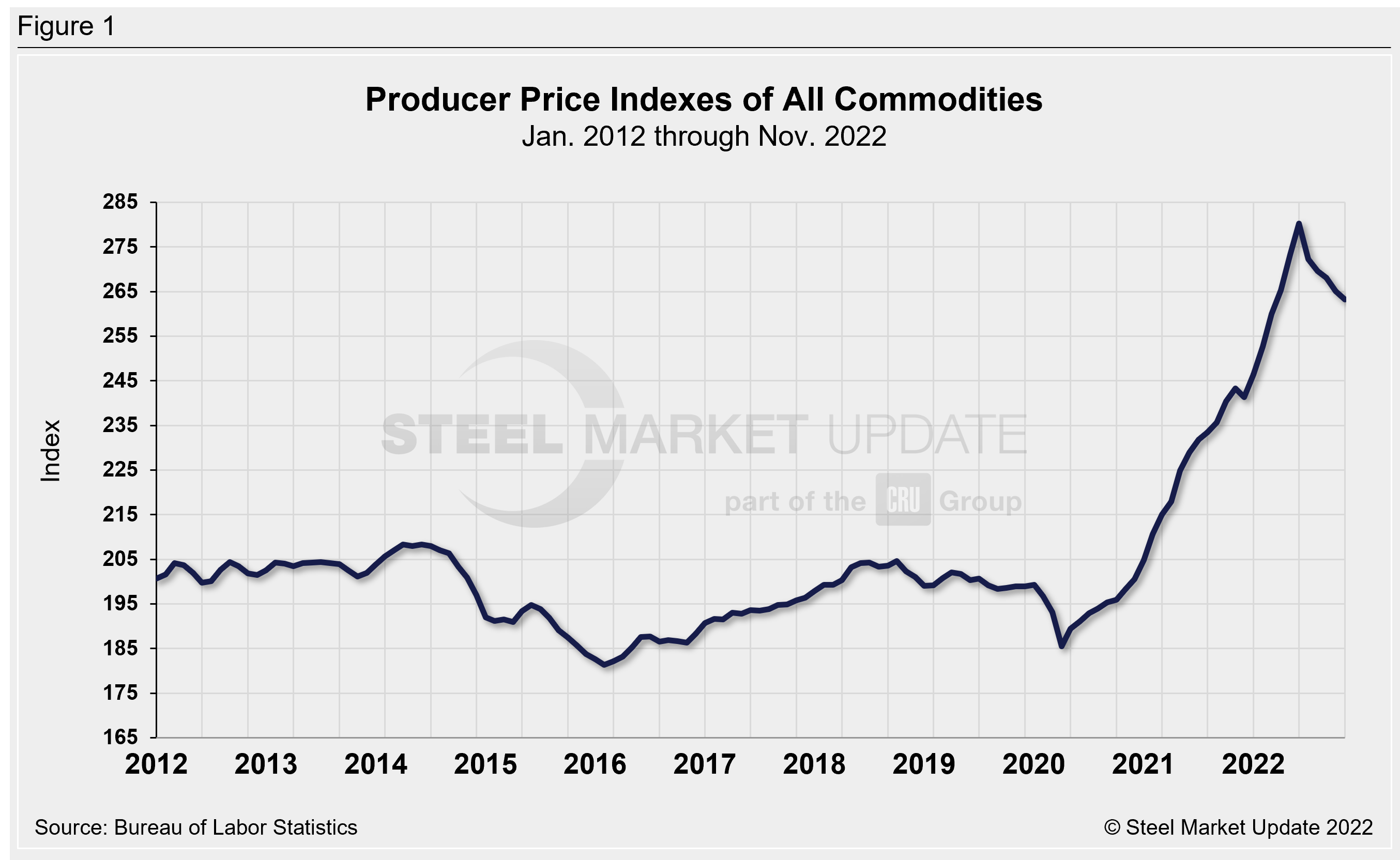
A summary of each segment’s change on a one-, two- and three-year basis are shown in the table below. The gain/loss pattern is shown by the color codes. Rising prices are considered positive. The positive swing on a 12- and 24-month basis is no surprise, given a strong recovery following Covid lockdowns in 2020. The growth at 36 months, however, is significant. The clear surge not only reinforces this historic recovery but also the inflation that has taken hold.
The table includes direct comparisons where possible between steel and competing products, such as plastics. It also includes transportation, warehousing, and storage to better contextualize current market conditions. The decline in cold-rolled sheet and aluminum sheet prices are hard to ignore, while construction-related products are up anywhere from 8.2% to 20.6% at the 12-month level, with similar increases for the 24- and 36-month periods.
The market has been resilient despite the impact of rising inflation, which has been significantly higher than forecasted. But the rate of price gains for some products has slowed despite continuing supply-chain bottlenecks, and in some cases has been slipping.
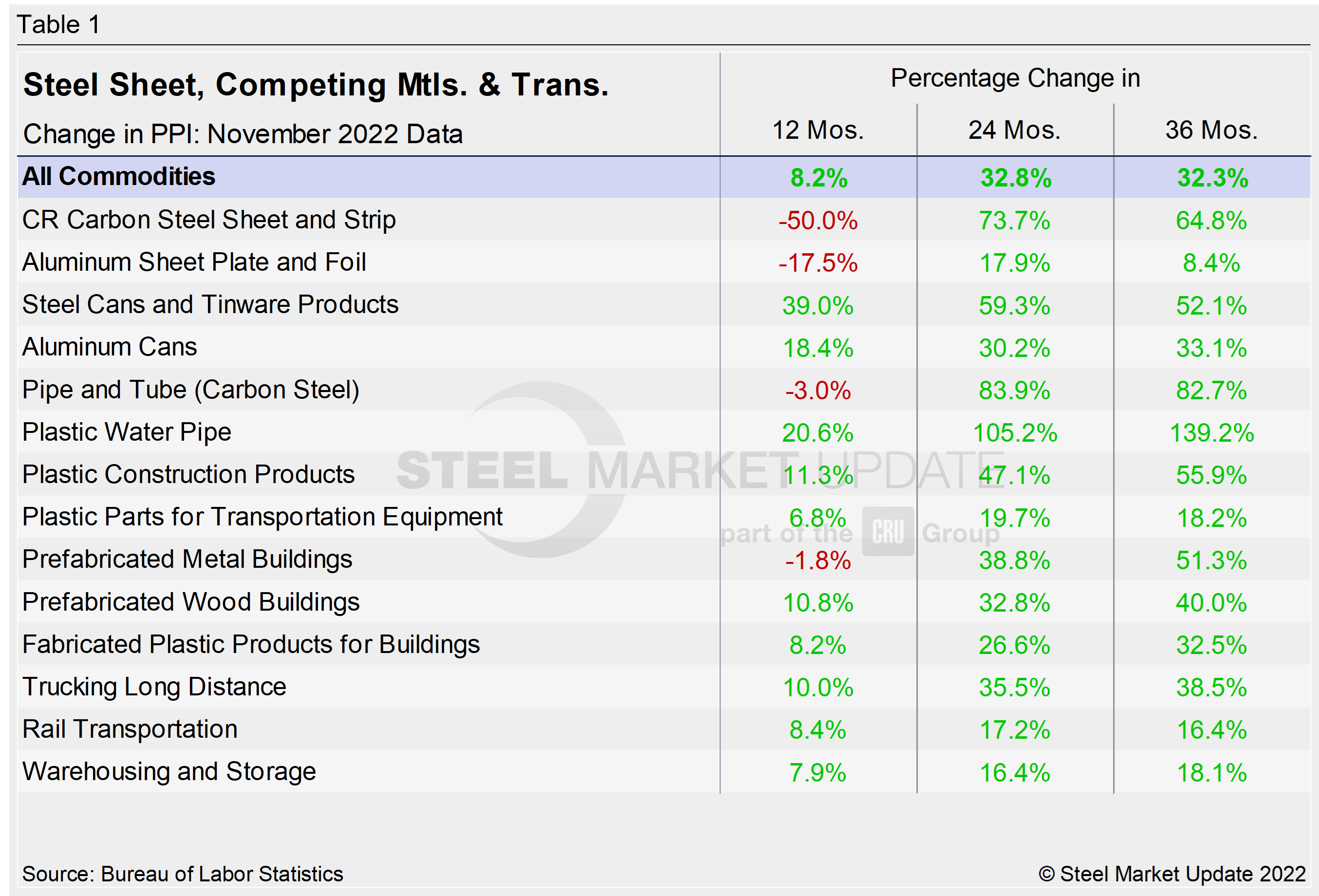
Both steel and aluminum products (Figure 2) had easily overtaken pre-pandemic PPI figures, reaching unprecedented highs. They saw additional support in the early days of the war in Ukraine, sparked by concerns about raw materials prices and additional supply-chain disruptions. As the shock of the war faded, prices retreated at an accelerated rate.
The trajectory in cold-rolled steel sheet prices overshadowed the impressive rebound in flat-rolled aluminum. But the decline has also been as precipitous as the rise, declining at an unprecedented rate.
Both cold-rolled steel sheet and flat-rolled aluminum fell in November versus the prior month. Cold-rolled steel prices declined 3.3% MoM in November, while flat-rolled aluminum declined by 1.9% over the same period. Cold rolled is down 47.7% YTD and down 50% YoY.
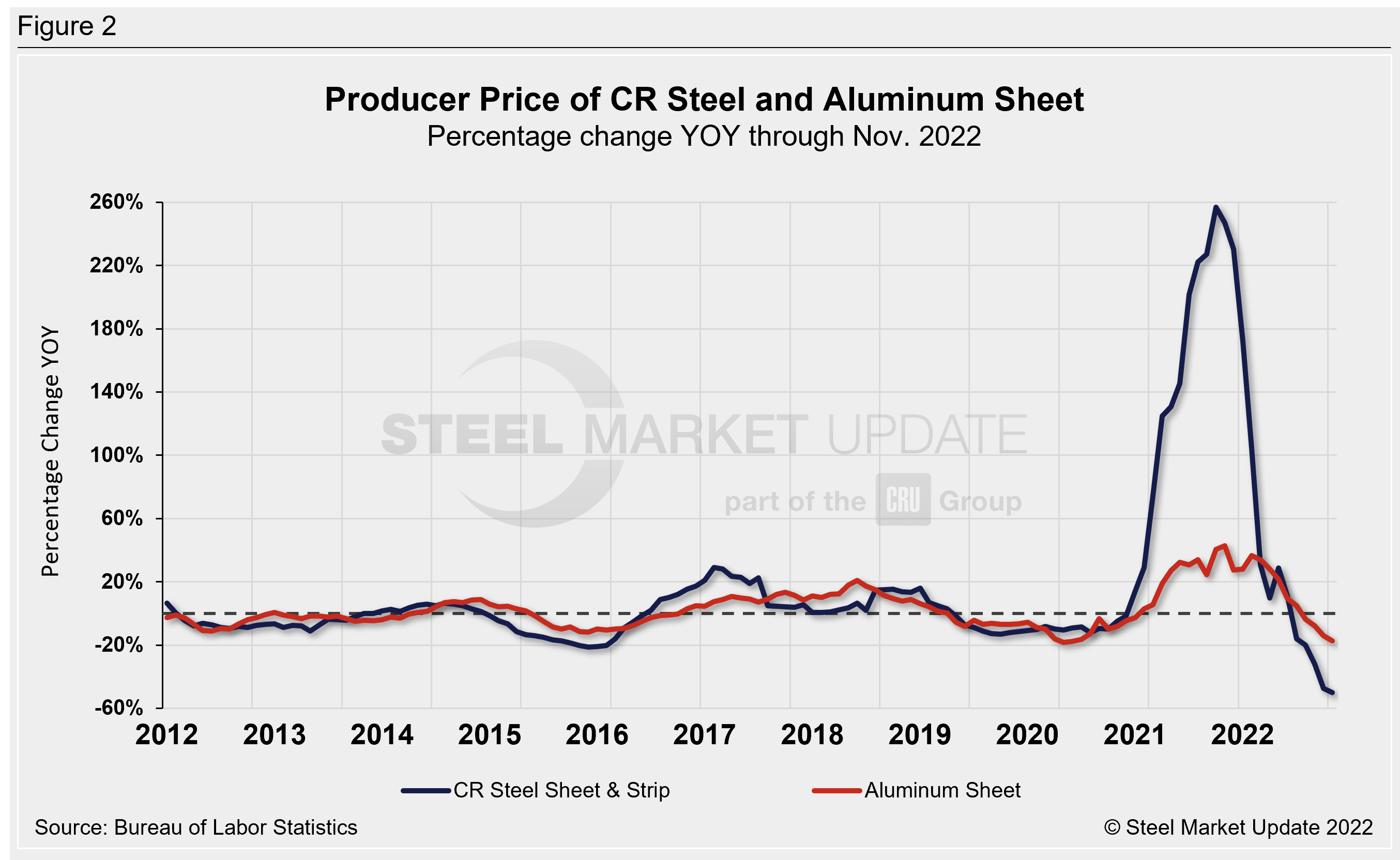
Prices of prefabricated metal buildings and prefabricated wood buildings have both seen significant increases since the beginning of 2021 and carrying into 2022. The rate of growth has turned with repeated decreases over the past three months.
Prefabricated steel building prices have seen a complete collapse YoY, down 1.8% over the past 12 months and down 0.4% MoM. Prefabricated wood buildings have been a bit more buoyant over the same period. They are up 0.4% MoM and remain up 10.8% YoY, and have been a major driver of elevated input costs in the construction sector.
The prices of steel and plastic pipe have both experienced big swings because of the pandemic. Plastic pipe price growth has stalled and turned slightly in November, down 0.1% MoM. Steel pipe prices have declined, in line with the same trend seen across most steel products.
Steel pipe prices slipped 2.2% MoM in November and were down 3% YoY. While plastic pipe prices slipped MoM for the first time in November, they were still up 20.6% over the same period. Figure 3 is a side-by-side comparison of prefabricated buildings and pipe price dynamics.
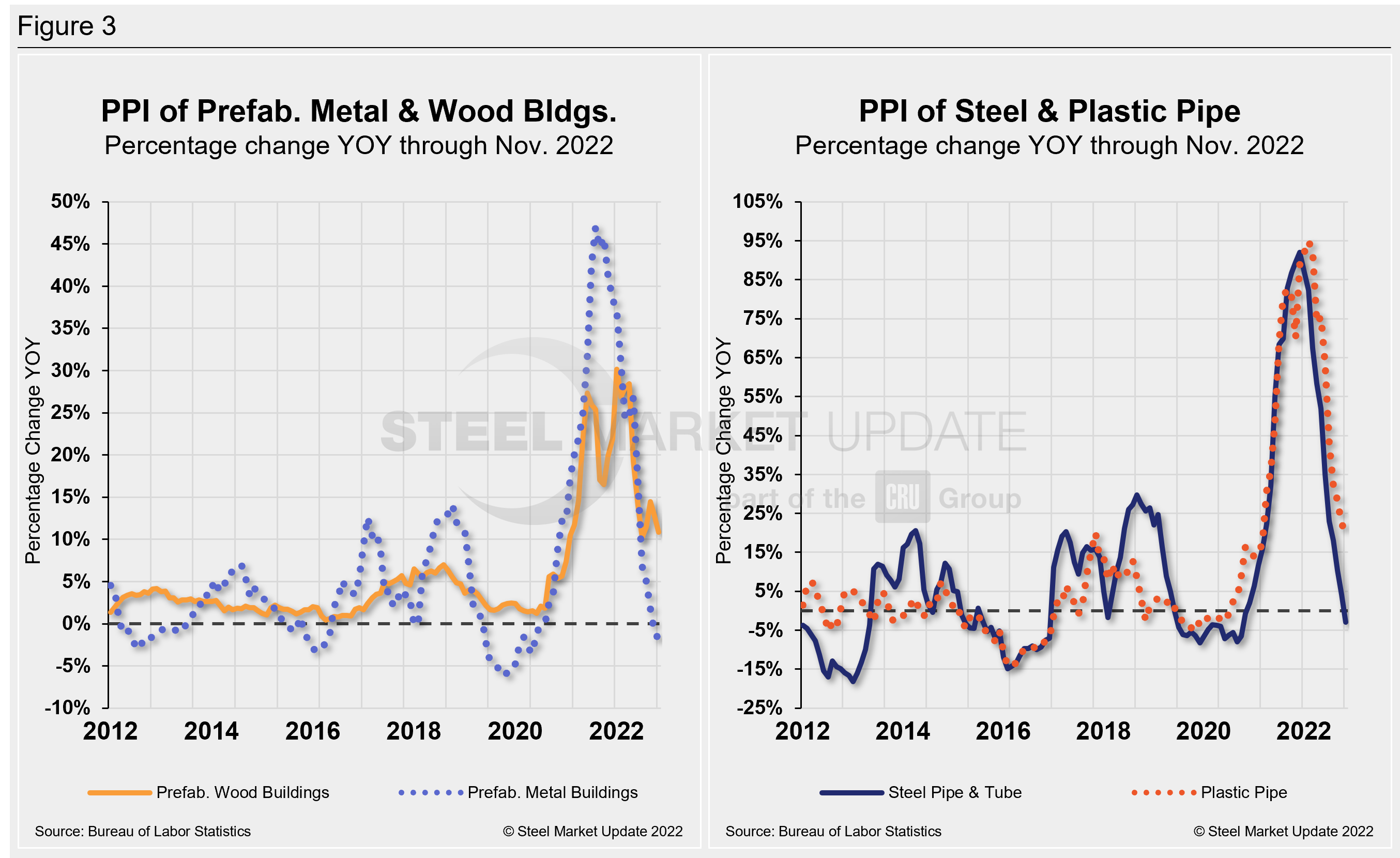
The growth of truck transportation prices has far exceeded that of rail since they both bottomed out in June 2020, though trucking has seen a major step down since May. Rail has also seen a decline in its rate of rise over the same period, though far less accentuated. Long-distance trucking was up 1.6% MoM in November and up 8.2% YoY, while rail was up 0.6% and 8.4% over the same periods.
Warehousing and storage prices have also risen but have fluctuated for much of 2022. Although erratic at times, they have been on a sharp decline since August. Last month’s reading of 128.8 is up 0.1% MoM and still up 7.9% YoY. Figure 4 is a side-by-side comparison of transportation and warehousing dynamics.
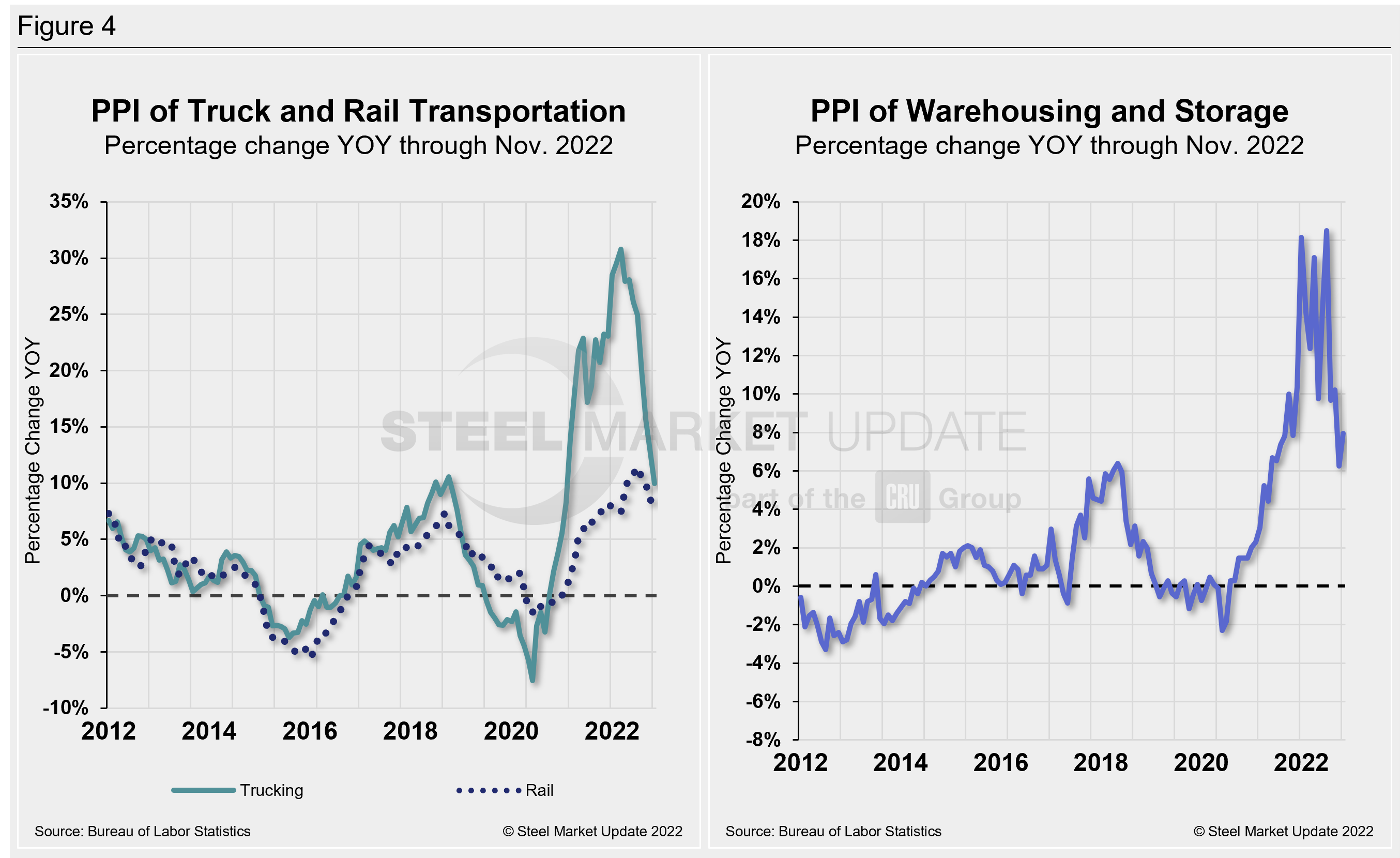
The official description of this program from the BLS reads as follows: “The Producer Price Index (PPI) is a family of indexes that measure the average change over time in the prices received by domestic producers of goods and services. PPIs measure price change from the perspective of the seller. This contrasts with other measures, such as the Consumer Price Index (CPI). CPIs measure price changes from the purchaser’s perspective. Sellers’ and purchasers’ prices can differ due to government subsidies, sales and excise taxes, and distribution costs. More than 10,000 PPIs for individual products and groups of products are released each month. PPIs are available for the products of virtually every industry in the mining and manufacturing sectors of the US economy. New PPIs are gradually being introduced for the products of industries in the construction, trade, finance, and services sectors of the economy. More than 100,000 price quotations per month are organized into three sets of PPIs: (1) stage-of-processing indexes, (2) commodity indexes, and (3) indexes for the net output of industries and their products. The stage-of-processing structure organizes products by class of buyer and degree of fabrication. The commodity structure organizes products by similarity of end use or material composition. The entire output of various industries is sampled to derive price indexes for the net output of industries and their products.
By David Schollaert, David@SteelMarketUpdate.com

David Schollaert
Read more from David SchollaertLatest in Steel Markets

Hot-rolled coil buyers continue seeking certainty
Steel market participants contend that buyers will remain in “wait-and-see" mode until some market stability is restored.

Latin American steel advocates warn on cheap import flood
Subsidized Chinese steel imports and cheap steel products from Association of Southeast Asian Nations (ASEAN) entering Latin American (LATAM) are threatening the region's steel market.

CRU: Steel prices fall amid global demand weakness
The forceful headwinds bearing down on steel markets across the globe have created demand challenges and sent prices southward. The US, however, challenged the global trend.

Hot-rolled price hikes garner mixed reactions from the market
Several steel market sources say they were blindsided when mills increased spot prices for hot-rolled coils this week.

Steel market participants mull the impact of US/Mexico S232 negotiations
Steel market participants learned that negotiations between the US and Mexico include discussions about Section 232 tariffs on steel and aluminum despite President Trump’s June 3 proclamation increasing the tariffs from 25% to 50% for all steel and aluminum imports—except for those from the UK.
